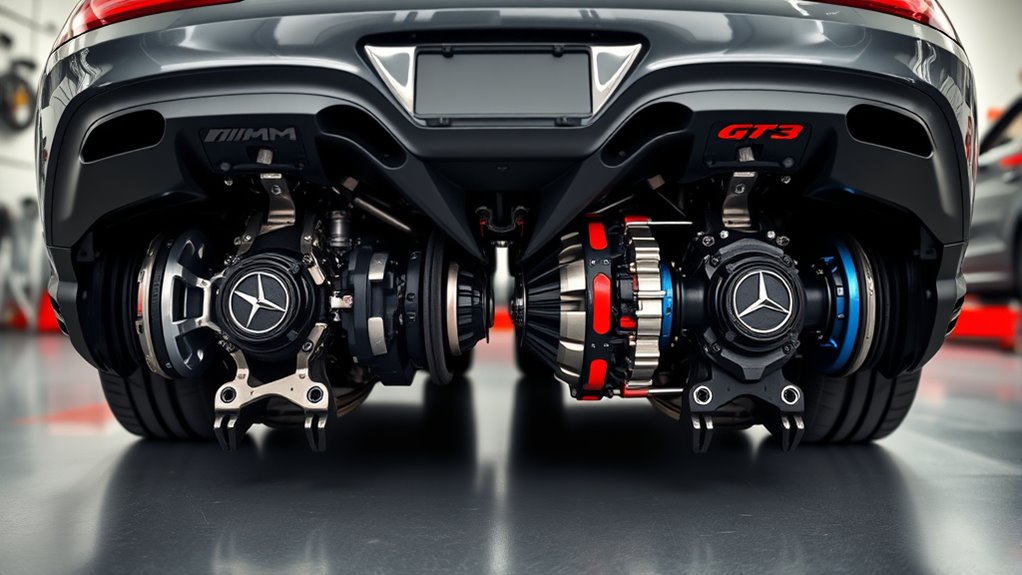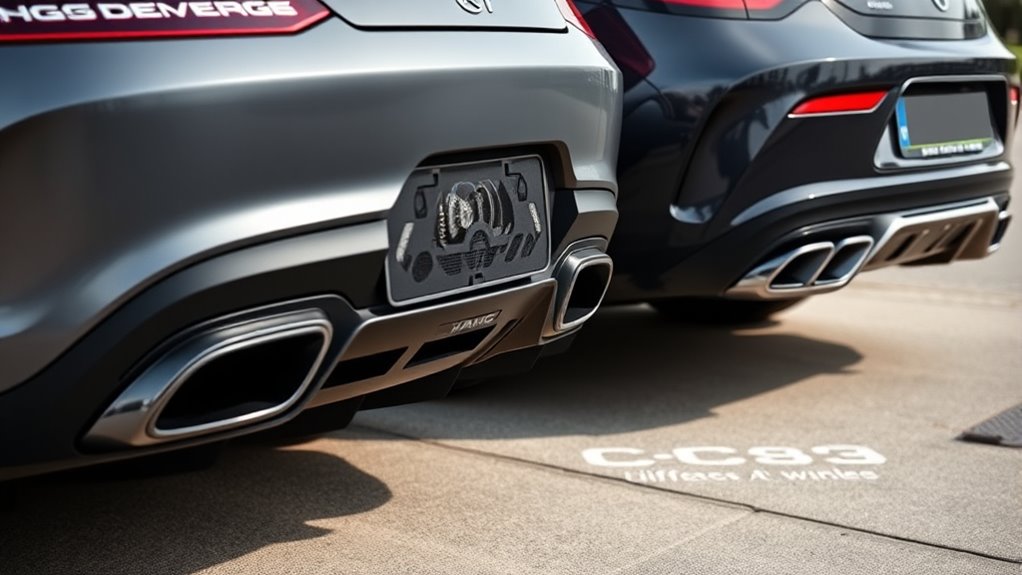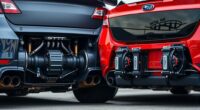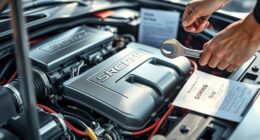Upgrading the differentials in your Mercedes AMG GT and C63 can boost traction, improve handling, and customize your driving experience. You can opt for mechanical LSDs like clutch packs or waveTrac units for predictable performance, or electronic E-Diffs for adaptive control. Gear ratio tweaks also enhance top speed and responsiveness. Choosing the right upgrade depends on your goals and model specifics. Keep exploring to discover detailed options and best practices to maximize your car’s performance.
Key Takeaways
- Upgrading clutch packs or installing Wavetrac and Quaife mechanical LSDs improves torque distribution and reduces wheelspin.
- Electronic E-Diffs and ECU tuning enhance traction, cornering, and stability with adaptable, sensor-based differential control.
- Compatibility varies by model; verify casing and gear ratios before installing aftermarket gear sets or mechanical upgrades.
- Reinforcing differential housings with billet covers and maintaining proper fluid levels extend component lifespan.
- Professional installation and thorough testing ensure optimal performance of differential upgrades on Mercedes AMG GT and C63.
Overview of Differentials in Mercedes AMG Models

Mercedes AMG models utilize advanced differential systems designed to enhance traction, handling, and performance. The front axle differential distributes torque from the transmission to the front wheels, managing slip during straight-line driving. Meanwhile, the rear axle differential acts as the main workhorse, variably sending torque between the rear wheels through a multiplate clutch with up to 1000 Nm capacity. The clutch actuation employs an electromechanical motor and ball-ramp mechanism, enabling precise clutch pressure. Defaults typically send 100% torque to the front, shifting to a 50:50 split during slip or driving mode changes. These systems are integrated with ESP and other control units, which dynamically monitor wheel rotation differences and adjust clutch engagement in real time, ensuring ideal traction, stability, and handling across various driving conditions. Attention in the creative process, such as in designing or tuning differential systems, can lead to more innovative and effective solutions. Incorporating advanced differential technology can further optimize vehicle dynamics and driver experience.
Types of Upgrades Available for AMG Differentials

To enhance the performance of AMG differentials, a variety of upgrade options are available that target grip, durability, and handling. Performance upgrade packs like RacingDiffs improve predictability and robustness, while WaveTrac ATB differentials use helical gears for better cornering traction. For straight-line stability, 100% locking LSDs (e.g., S63 AMG) are ideal. Billet covers reinforce housing strength, and clutch rebuild kits restore and upgrade friction components. Front LSD solutions, such as PTG’s, reduce wheelspin and improve steering. ATB options like Quaife enhance acceleration without clutch wear, thanks to their gear design. These upgrades can be combined with ECU tuning for maximum traction and handling. Understanding the individual responses to different upgrades is crucial, as individual responses vary based on personality and driving style. Additionally, staying informed about emerging market trends can help optimize upgrade choices for future performance gains. Incorporating high-quality components and considering customer reviews can also guide effective upgrade decisions. Being aware of survivalism concepts like durability and resilience can also be beneficial when selecting components for long-term reliability. Furthermore, paying attention to component compatibility ensures seamless integration of upgrades and sustained vehicle performance.
Mechanical vs. Electronic Limited Slip Differentials

Mechanical and electronic limited slip differentials (LSDs) each offer distinct advantages that influence how your vehicle handles and responds during dynamic driving. Mechanical LSDs use clutch packs for torque biasing, providing immediate engagement during slip and direct feedback, ideal for predictable track performance. They operate independently and have fixed preload, but clutch wear can limit high-torque handling and require maintenance or aftermarket upgrades. Clutch wear can be a limiting factor in high-torque applications, necessitating regular inspection and potential component replacement. Additionally, performance upgrades for differentials can further optimize handling characteristics tailored to your driving needs. Mechanical LSDs often require precise setup and tuning to achieve the desired balance between slip and grip, making professional calibration beneficial. E-Diffs utilize electronic controls and hydraulic actuators, modulating wheel slip based on sensor inputs. They adapt to conditions like rain or snow, reducing drivetrain shock through torque modulation and integration with stability systems. While they introduce slight latency, E-Diffs excel in variable conditions and offer enhanced durability in everyday driving. The ability to customize the torque distribution electronically allows for a more adaptable driving experience. Choosing depends on whether you prioritize direct, driver-controlled response or adaptive, automated traction management. For many modern vehicles, traction management systems are integrated with electronic differentials to improve safety and performance across diverse driving scenarios.
Enhancing Traction and Handling Through Differential Tuning

Tuning your differential is a proven way to boost traction and improve handling, especially during aggressive driving or cornering. By upgrading components like the clutch pack or installing a Wavetrac differential, you optimize torque distribution, reducing wheelspin and enhancing stability. Electronic upgrades, such as torque vectoring and ESP software updates, refine electronic differential behavior, offering precise control and better cornering. You can also improve mounting stability with rubber bushing upgrades, which lessen unwanted movement and vibrations. Proper differential tuning can significantly influence vehicle dynamics, helping you tailor handling characteristics to your preferences. Additionally, understanding the sound healing science behind vibration and frequency can inform how you approach suspension and component tuning for optimal performance. Recognizing the importance of gear shifting techniques can further complement your differential upgrades, ensuring smoother power delivery. Here’s a quick comparison:
| Upgrade Type | Benefits |
|---|---|
| Wavetrac Differential | Superior torque distribution, durability |
| Clutch Pack Upgrades | Restores performance, reduces slip |
| Electronic Torque Vectoring | Precise handling, improved cornering |
| Mounting and Bushing | Better stability, long-term durability |
| LSD Compatibility | Enhanced traction under high power |
Additionally, understanding the differential’s role in vehicle dynamics can help you choose the most suitable upgrade for your driving style. Proper differential tuning can significantly enhance your vehicle’s overall handling experience. These upgrades deliver more responsive handling and consistent traction for your AMG.
Considerations for Gear Ratio Modifications

When considering gear ratio modifications for your Mercedes AMG, evaluating compatibility with your differential casing is essential before making any swaps. Different models, like the W204 C63 coupe and sedan, have varying stock ratios—3.06:1 and 2.82:1, respectively—that influence performance. Aftermarket options, such as 2.65:1, can enhance top speed and highway efficiency but may reduce low-end torque. Confirm that the differential housing can accommodate the new ratio, especially if upgrading to a complete gear set with matching ring and pinion. Be mindful that taller gears increase driveline stress during aggressive launches and may require electronic recalibration for speedometer and ESP functions. Ensuring compatibility and aligning your gear ratio choice with your driving goals is key to a successful upgrade. Understanding differential compatibility can help prevent installation issues and optimize performance.
Installation Challenges and Best Practices

Installing a new differential on your Mercedes AMG requires careful preparation to avoid potential setbacks. Start with a thorough inspection to identify hidden issues, guaranteeing all components are compatible. Removing the old unit demands precision; inspect axles and driveshafts for wear, and handle differential fluid carefully to prevent leaks. Using specialized tools may be necessary for a smooth installation. To minimize problems, opt for high-quality OEM or aftermarket parts, and follow detailed step-by-step guides. Engaging professional mechanics can help navigate complex procedures and ensure proper alignment. After installation, perform thorough testing to confirm all components function correctly. Regular maintenance checks, such as fluid changes and axle inspections, will help sustain performance and prevent future issues. Recognizing soulmate angel numbers can also provide spiritual reassurance during major vehicle upgrades, emphasizing the importance of patience and trust in the process. Additionally, understanding Lifevest Advisors recommendations on avoiding scams and managing investments can offer peace of mind during any significant upgrade or maintenance project. Moreover, paying attention to essential oil benefits related to vehicle maintenance can enhance your overall experience by promoting a calm and focused mindset during complex procedures. Incorporating technological advancements in automotive repair can also streamline diagnostics and improve the accuracy of repairs, leading to better long-term results. Being aware of Glycolic Acid Benefits for Skin might seem unrelated, but taking care of your skin during these intensive tasks can help maintain focus and comfort.
Impact of Upgrades on Vehicle Performance and Reliability

Upgrading the differential in your Mercedes AMG GT or C63 can substantially boost performance and reliability by improving traction, handling, and stability. Enhanced LSDs distribute power more evenly, reducing wheelspin and delivering better cornering. This results in quicker launches, improved stability, and smoother power delivery. Proper upgrades can also address differential issues like clutch wear, restoring efficiency. To maximize benefits, complementary tuning, such as ECU adjustments, is essential. Consider the following:
| Benefit | Impact |
|---|---|
| Performance | Faster acceleration, better cornering grip |
| Reliability | Reduced risk of differential failure |
| Handling | Increased stability during high-speed turns |
| Tuning Compatibility | Ensures system integration and ideal function |
Choosing the right upgrade enhances both vehicle performance and longevity. Additionally, understanding the financial management aspect of vehicle upgrades can help you budget effectively for these enhancements. For optimal results, aligning differential upgrades with residency requirements and ensuring compatibility with your vehicle’s specifications are crucial for maintaining reliability and performance. Furthermore, adhering to software quality assurance best practices can ensure that any ECU tuning is performed reliably and safely.
Market Options and Choosing the Right Differential Upgrade

Although options for differential upgrades in Mercedes AMG models are somewhat limited, several aftermarket solutions can still considerably enhance traction and handling. You’ll find aftermarket clutch packs from companies like RacingDiffs that restore LSD performance and address wear issues. For non-S models, clutch-type LSDs are common upgrades, while S variants often feature electronic differentials (E-Diffs) for improved traction control. When choosing an upgrade, consider your vehicle’s specifications, like whether it’s a C63 or AMG GT, and your performance goals—whether for daily driving or track use. Reputable providers such as Wavetrac and RacingDiffs offer high-quality LSD solutions. Ensure professional installation and compatibility with other modifications to maximize benefits, and prioritize trusted brands to ensure reliability and support.
Frequently Asked Questions
How Do Differential Upgrades Affect Warranty Coverage?
When you upgrade your differential, it can impact your warranty coverage. Installing aftermarket parts may void your warranty if repairs become necessary due to those modifications. It’s important to check with your dealer beforehand, as they might require inspections or documentation. Keep in mind, support for repairs on upgraded parts likely won’t come from Mercedes, so you may need to rely on the aftermarket supplier for assistance.
Are Electronic LSD Upgrades Compatible With All AMG Models?
Imagine fitting a finely tuned puzzle piece into a complex machine; electronic LSD upgrades aren’t a perfect fit for all AMG models. You might find they work seamlessly with certain W204 and W212 variants, especially those with compatible traction control systems. However, newer models like the AMG GT typically require factory-specific electronic systems, making aftermarket electronic LSDs less compatible or necessitating extensive modifications. Always verify your model’s electronic architecture before considering such upgrades.
What Is the Typical Lifespan of Upgraded Clutch Packs?
The typical lifespan of upgraded clutch packs varies based on driving habits and maintenance. You can expect them to last between 30,000 to 100,000 miles, especially if you drive aggressively or frequently track your car. Proper cooling and regular maintenance can extend their life. Keep in mind, heavy use and poor upkeep may shorten their durability, so investing in quality parts and proper care is key.
Can Differential Upgrades Improve Fuel Efficiency?
You might wonder if differential upgrades can boost fuel efficiency. Usually, they don’t have a significant impact because they’re designed mainly to improve handling and traction, not save fuel. While better traction can reduce wheelspin and energy loss, the effect is minimal. Most upgrades focus on performance, so don’t expect noticeable fuel savings. If you want better efficiency, other modifications or driving habits will make a bigger difference.
Do Aftermarket Differentials Void Insurance Policies?
You might wonder if aftermarket differentials void your insurance policy. Generally, insurance companies don’t explicitly state that modifications like differential upgrades automatically void coverage. However, you need to disclose these upgrades, or your policy could be at risk in a claim. Each insurer handles modifications differently, so review your policy details carefully. To stay protected, consider informing your insurer about any aftermarket parts to avoid potential coverage issues.
Conclusion
Upgrading your Mercedes AMG GT or C63 differential isn’t just about boosting performance—it’s about releasing a new level of driving excitement. As you explore different options, you might find that the perfect upgrade coincidentally aligns with your driving style, turning every twist and turn into a thrilling experience. When you choose wisely and install carefully, you’ll enjoy enhanced traction, sharper handling, and a newfound confidence behind the wheel—making every drive feel unexpectedly extraordinary.










